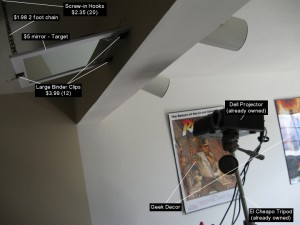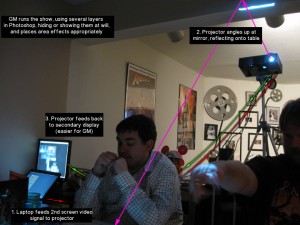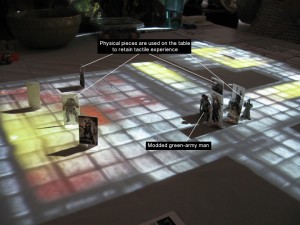Dungeons and Dragons and Projected Maps
Believe it or not, I didn’t experiment with D&D as a kid and 35 years of age seems like an odd time to start, but start I did. Fortunately, I found a few like minded (and aged) friends willing to give it a shot. To be honest, I’ve never really been a fan of those sort of board games that encourage co-operative play in order to beat “the system”, nor have I been the type of guy with the patience to sit for 8 to 10 hours at a time playing a game…even video games. I can’t explain why Dungeons and Dragons is different. 6 guys huddled around a table pretending to be medieval characters on a quest to prevent a rift to some evil dimensions from opening sounds silly. And it get’s silly, but it’s fun and a great excuse to get the guys together for some snacks, drinks and a few laughs.
I’m never content with doing things normally though. When we decided to start these semi-monthly sessions, my mind immediately floated to using a Microsoft Surface-like table, something I am far from affording. For about five minutes, I looked up how to build a touch table on my own, but it took about 5 seconds to realize I’ve got no business attempting a project that ambitious. Instead, I hunted around to find a way to boost our games beyond the typical nerdery. I found this.
Using the Unreal Development Kit was also a little too ambitious, partially because I’d never used it before and I’m not the Game Master, so I wasn’t supposed to know the maps ahead of time. I really liked the idea of projecting an animated map onto the table. The GM really liked the idea of not having to print out and cart around a bunch of paper maps. I considered using Flash to create maps and animated flourishes, but again, we’re talking about a lot of work for a program I’m only moderately familiar with. Photoshop, on the other hand, I can work with in my sleep. My GM aint so shabby either.
So here’s the setup. Using a Dell projector, set up on a tripod, the display is sent from a laptop stationed with the GM and then sent back from the projector to a secondary screen. The GM brought in his maps and area effect designs as multiple layers, using solid black layers as a “fog of war” that he could turn on and off to gradually reveal areas of each dungeon and to spring traps on us unsuspecting adventurers.
We still use physical player and creature pieces, because without them I believe a lot is lost from the whole RPG experience. That said, the projected image of each map in a darkened room makes for an ambiance that not only captures the basement-dwelling feel that I never got as a kid, but is just plain cool.
There will be improvements: The mirror I’m using needs to be a bit larger. Its frame cuts into a bit of the picture, but it’s not difficult to work around. On the table, I’m using a simple plastic tablecloth that offers a decent reflective surface without a glare, but it’s semi-transparent and so thin that even rolling the dice has a tendency to mar it. I’ve already ordered off for a sheet of leather-vinyl; easily wiped down, solid, quickly rolled up and stored away and relatively cheap, it should make for a good play surface. Putting a DLP projector on a 20 dollar tripod doesn’t inspire the greatest of confidences, so that may change, but for now, it works well.
If you’ve got suggestions, questions or comments, I welcome them below. I hope this inspires a few out there. I realize this isn’t the most unique setup, but I’m still proud of it and thinking about trying other, more traditional games (Settlers of Catan anyone?).



























If your going to replace the mirror, get a first surface mirror. This will prevent ghosting of the image. If you go to http://www.enworld.org , you can find some great setups that I and other members have come up with.
I don’t have any noticeable ghosting issues, but I’ll look into it. At first glance, a 16″x16″ inch First Surface mirror runs $88 bucks, way more than I’m willing to drop for this project. If I ever get the chutzpa to attempt a touch-table build, then that might be the least expensive part of the whole build.
would the quality of the map be different if the projector was mounted to shoot directly onto the table by chance?
Not really, but that doesn’t mean there aren’t other benefits. Doing a straight down projection affords you less time in initial setup since you won’t have to adjust the “pin cushion” angles to compensate for mirror’s bounce. Plus, you won’t have to invest in a mirror. However, one of the big downsides is that unless you are using a short-throw projector, you’ll probably need to raise it pretty high above the table. That means REALLY securing the projector to the ceiling, else risking what could be a pricey and possibly painful accident.